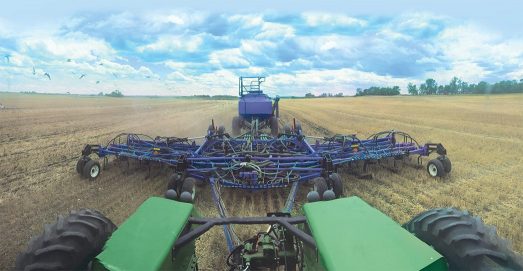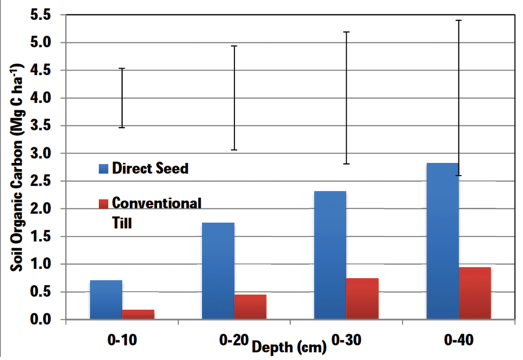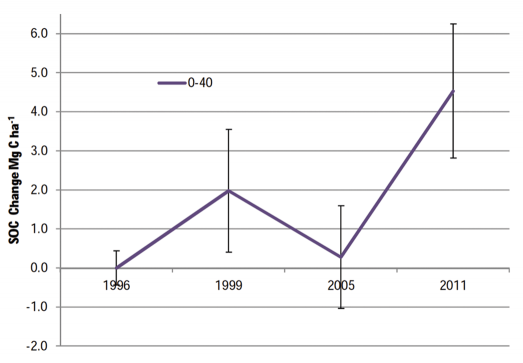A Saskatchewan soil sustainability story

The Canadian Prairies in the 1980s was a dry and windy place to be. Farmers, government and researchers all recognized the critical importance of protecting the most valuable resource required for growing crops. In 1987, the Saskatchewan Soil Conservation Association (SSCA) was established to encourage soil conservation. The Save Our Soils program was initiated to accomplish soil conservation through a variety of mechanisms. It was funded largely by a federal-provincial partnership to send regional soil conservationists into the community.
“Weed control, crop establishment, fertilizer placement, rotation and straw/chaff management were the five pillars,” stated Pat Flaten, one of the former soil conservationists. She can still list the key components of their program off the top of her head. When asked about how they reached farmers with their message, she explained innovation in action. “We had these binders with all the information, but really we did everything we could, accessing growers through town meetings, field days, trade shows. Wherever farmers were, we were too, and because of the field conditions over the previous decade, everyone was committed to protecting the soil.”
Be in the know! For the latest canola news and information, follow @SaskCanola on Twitter and like @SaskCanola on Facebook.
SSCA and government extension specialists talked about the research and practices that could be implemented on farm, but seeding equipment developers were also coming out with new technology that made direct seeding possible. The introduction of herbicide-tolerant canola was a timely catalyst for a shift across the province toward conservation tillage practices on a large scale.
After some recognition that the needle had moved on soil conservation, SSCA narrowed their focus. There was a conscious decision on the part of the extension specialists to concentrate solely on reduced tillage. The SSCA board also took the opportunity to understand everything they could about this concept of carbon credits, and what it meant for Saskatchewan farmers.
John Bennett, a former member of the SSCA board, talks about the role that they played as farmer directors. “We spent a lot time researching this idea, it was very new. We quickly realized that it was an opportunity for farmers to be recognized and rewarded for their stewardship efforts.” As a member-driven organization, they had to be nimble and respond to the changing landscape of the industry. There had been a lot of success on the soil conservation initiative, and they wanted to keep that momentum going.
“The Prairie Soil Carbon Balance project provided a benchmark and a dataset. We knew that an increase in soil health and quality was having positive results, and we quickly learned that soil organic matter was the easiest measure of carbon sequestration,” Bennett explains. “In order for farmers to participate in a functioning market, we needed to prove that we were doing something that could be measured.” As a board, they also realized there was an opportunity to once again raise awareness among the farming public. At the time, not a lot of farmers had a solid understanding of the positive impacts they were having on the environment by storing carbon in the soil with reduced tillage. Not to mention the future market opportunity in a world where a price is placed on carbon.
Over a 22-year period, the Prairie Soil Carbon Balance has measured almost 140 sites across Saskatchewan. The results are a good news story. Models have guided the discussions on carbon sequestration because of limited datasets. The data in Saskatchewan has exceeded the expectations of these models and demonstrated that farmers are contributing even more than originally expected by practicing conservation tillage. An average of 0.38 tons of CO2/acre/year of carbon is stored in the soil using conservation tillage programs. This is equivalent to a 1,321 kilometre trip of an average passenger vehicle. Across the 23 million acres in Saskatchewan that are currently direct seeded, this represents enough carbon-storage capacity to offset 30 million kilometres of driving annually. That is the equivalent to taking two million cars off the road.
The announcement of a national climate change strategy which includes a provision for carbon pricing has negative implications for carbon intensive industries like agriculture, particularly for grain farmers. Both the national and international policies mention the importance of natural sinks, which can be great opportunity for farmers to be a part of the solution and offset industrial emissions for our trade sensitive resource economy. A coalition of crop commissions and associations in Saskatchewan are working with the SSCA to communicate the value that farmers provide through conservation tillage practices.
The most important piece of the soil sequestration story is that farmers are doing this for the best interest of the environment. They are capturing carbon in their soils to increase soil organic matter, which offsets industrial carbon emissions. According to the research that has been going on for more than two decades, there is an accumulation of carbon that far exceeds the single shift from traditional tillage to direct seeding. Farmers are not looking for any kind of retroactive payment for this value, but an opportunity to participate in the market into the future for their annual contribution.
Soil Organic Carbon under direct seeding versus conventional tillage from 1996 to 1999 at four depth increments (n=22; LSD p=0.05).

Changes in soil organic carbon (SOC) under direct seeding, given as Megagrams (tonnes) of carbon (C) per hectare.






